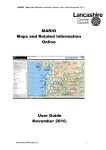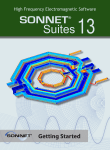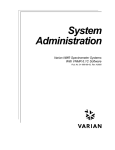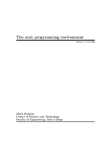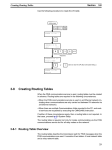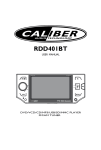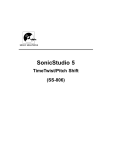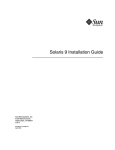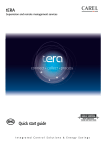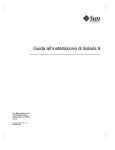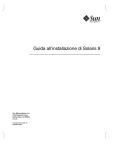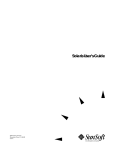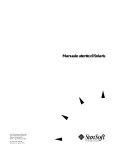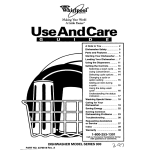Download Release 4.0 Change Notes/or the Sun
Transcript
Release 4.0 Change Notes/or the Sun
W orkstation®
Sun Microsystems, Inc.
•
2550 Garcia Avenue
•
Mountain View, CA 94043
•
415-960-1300
Part No: SOG-1731-07
Revision 50, of 19 January 1987
UNIX is a. registered trademark of AT&T.
Sun Workstation, SPARe, SunView,Sun-l,
Sun-2, Sun-3, and Sun-4
are trademarks of Sun Microsystems, Incorporated.
Multibus is a trademark of Intel Corporation.
VMEbus is a trademark of VMEbus Manufacturers Group.
'.
Copyright © 1987, 1988 by Sun Microsystems, Inc.
This publication is protected by Federal Copyright Law, with all rights reselVed.
No part of this publication may be reproduced, stored in a retrieval system,
translated, transcribed, or transmitted, in any fonn, or by any means manual,
electric, electronic, electro-magnetic, mechanical, chemical, optical, or otherwise, without prior explicit written permission from Sun Microsystems.
Contents
Chapter 1 Release 4.0 Change Notes ........................................................................
3
1.1. Introduction .........................................................................................................................
3
Compatibility .......................................................................................................... y......
3
1.2. New Hardware SUPJ>Ort ................................................................................................
3
1.3. System Software Changes and Upgrades ..........................................................
3
NFS and the File System Reorganization in 4.0 .........................................
3
Changes to boot ........................................................................................................
4
General Software Changes ......................................................................................
4
signal handlers ............................................ ...................................................... ........
4
getdents ...............................................................................................................
4
O_SYNC ......................................................................................................................
4
Time Zones .................................................................................................................
4
oJ)en files J)er process ............................................................................................
5
C ........................................................................................................................................
5
General C Library Changes .....................................................................................
5
printf ......................................................................................................................
5
regexp ..............................................................................................;........................
6
New hostent structure ................................................................. ;;........................
6
1.4. Utilities .........................................................................................~........................................
6
Telnet improvements .............................................. .L ..,.. "......~••"'.........................
6
FfP fully implemented .....................................;..........;;~ .................. ~.................
6
TFTP defaults to secure ................................................~.LL...:.~,..........................
6
VeIbose etherfind ........................................................................................
6
on command suspension ..................................................................................
6
-ili-
Contents - Continued
format ...........................................................................................................................
6
suninstall ......................................................................................................................
7
Mail TransJ)(>rt System ..............................................................................................
7
Mailboxes on servers .............................................................................................
7
Error message improvements ...........................................................................
7
Mail Exchanger sUPlX>rt ......................................................................................
7
Inverted alias mapping .........................................................................................
7
Automatic Domain Configuration .................................................................
7
1.5. New Security Feamres ..................................................................................................
7
1.6. System V Compatibility ..............................................................................................
8
New cron and at ..............................................................................................
8
ed ...................................................................................................................................
8
sh ..............................................................................................................................:;...
8
curses/terminfo ........................................................................................
8
System V STREAMS Interface ......................................................................
9
4.3BSD Enhancements ..............................................................................................
9
su ...................................................................................................................................
9
tcopy(l) ...................................................................................................................
9
fsck ............................................................................................................................
9
getty .........................................................................................................................
9
New Interface stIUcmre ........................................................................................
9
New buffering conventions ................................................................................
10
TCP urgent data ........................................................................................................
10
TCP .,erfoIlIlance ....................................................................................................
10
IP options .....................................................................................................................
10
Full ICMP support ..................................................................................................
10
Full IP sub netting ....................................................................................................
10
NIT Streams instead of Sockets _........................_.........................................
10
Alternative Protocol Arebitectures .. _............................................................
10
/ etc/ttys compatibility .............................................................................
10
syslog compatibility ...............................................................................................
11
sys10g daemon ...................................................................................................
12
inetd compatibility ..........................................................................................
12
- iv-
Contents - Continued
Line Printer Spc><>ler ...............................................................................................
12
select .................. _....................................................... _.........................................
12
System V and 4.3BSD combined functionality _.........................................
12
Shared Libraries and Virtual Memory ...... _......................................................
13
1.7. Ligllt weight processes ................................ _...............................................................
13
1.8. Programming Environment Changes and Upgrades ......... _.......................
14
Changes to me C compiler ......................................................................................
14
Changes to lint ..................................................................._...................................
14
1.9. SunView Enhancements ..............................................................................................
15
Summary of New SunView Features from Release 3.4 ....................
15
Walking Menus are Now me Default ................................................................
15
New Text Menu .............................................................................................................
16
Text Menu Layout ............................................................................................... _.
16
New Names .................................................................................................................
16
Find and Replace Pop-Up Frame ...................................................................
16
'Delimiter Matching ................................................................................................
17
Fields in Text windows ........................................................................................
18
Word Wrap Mode ...................................................................................................
18
'Extras' Menu ............................................................................................................
19
Keyboard Control of the Caret and Editing ...................................................
19
Alerts ....................................................................................................................................
21
Keyboard Accelerators for Alerts ..................................................................
22
Shadowed Frames and Menus ...............................................................................
22
File Size Limit on Editing Logs ...........................................................................
22
Buffer Size Limit when Editing Files ..........................................................
23
New mailtool .........................................................................................................
23
Simplified Control Panel .....................................................................................
23
Multiple Composition Windows ....................................................................
23
Separate Mail Composition Window...........................................................
23
Reply Control Panel...............................................................................................
24
Hierarchical Folders Menu ................................................................................
24
Input Focus ..................................................................................................................
24
Fields in Outgoing Messages ............................................................................
24
-v-
Contents - Continued
New Mail......................................................................................................................
25
Miscellaneous ............................................................................................................
25
8-Bit Suppon in shelltool and cmdtool ........................................
25
Underlining and Inverse in shelltool .....................................................
25
Frame Menu Changes .................................................................................................
26
'Props' Item in ilie Menu ................. _.................................................................
26
Oilier Name Changes ............................................................................................
27
Unconstrained Move and Resize ....................................................................
27
Odler SunView Changes ...........................................................................................
27
Files Renamed ...........................................................................................................
27
New SunView "Root" Menu ............................................................................
27
SunView Changes Visible to ilie Programmer ...................................... y....
27
Alerts ..............................................................................................................................
27
More File I>escriptors ...........................................................................................
27
Lines in Menus .........................................................................................................
27
Props Attribute ..........................................................................................................
27
Shadowed Frames ...................................................................................................
27
SunView Incompatibilities ......................................................................................
28
1.10. Finnware and Diagnostics Changes and Upgrades ...................................
29
1.11. PROM Changes for Sun-4 Architecture .............................................................
29
I>eleted Commands ................................................................................................
29
Changed Commands ..............................................................................................
29
-vi-
1
Release 4.0 Change Notes
1.1. Introduction
Compatibility
Release 4.0 software is designed to run on Sun-2, Sun-3, and Sun-4 systems.
With the elimination of the ND panition and the reorganization of the file system, Sun now has true heterogenity across these architectures.
1.2. New Hardware
Support
Software support is available for the following new hardware:
CI
The Sun-4 Workstation
CI
SCSI 112 Inch Tape Support
CI
Interphase VME SMD disk controller
CI
Xylogics 751 Support
CI
Sun Type-4 Keyboard
The keyboard is compatible with all Sun-2, Sun-3, Sun-4 and Road Runner
workstations.
1.3. System Software
Changes and Upgrades
NFS and the File System
Reorganization in 4.0
ND partitioning has been eliminated and the filesystem has been reorganized.
Now you can use the SUD Network File System (NPS) exclusively to support different architectures. The new layout provides the following:
o
Easier maintenance of seIVers and clients.
o
Easier mixing of remote and local filesystems.
CI
Cleaner support of multiple architectures.
CI
Minimal disruption to existing programs
o
Minimal symbolic link confusion.
For complete information on the new filesystem layout, see Installing the Sun
Operating System, Chapter 1.
3
Revision 50, of 19 January 1987
4
Re1e~e
4.0 Change Notes for the Sun Workstation~
Changes to boot
In previous releases booting a stand-alone workstation or a server from a local
disk has been done through code in boot which knew how to access and interpret a file system on that disk.
The following changes have been made to boot.
o
ND code has been eliminated, since servers no longer suppon ND operations.
o
The program boot now understands how to perfonn NFS file operations
over the net to a server with which the client workstation is registered.
For a complete explanation of this see System and Network Administration for
the Sun Workstation (800-1733).
General Software Changes
signal handlers
Functions that are specified as handlers for signals are now expected to be of type
"function returning 'void"', not "function returning 'int'''. This is the type
specified by the current IEEE POSIX standard draft. Since no use is made of the
return value of a signal handler, "void" is the correct type of such a function, not
"int".
Code written assuming that these functions were of type "int" will continue to
run and not be recompiled. If this code is recompiled, it does not need to be
changed, although warning messages about type clashes will be printed.
getdents
o
SYNC
Time Zones
A new SVID compatible getdents system call has been added to read directal)' entries. As with the old getdirentries system call, direct use of this
call should be avoided. Use the directory (3) routines instead.
The flag O_SYNC may be specified in the flags argument to "open" and "fcntI";
if this flag is set on a file descriptor that refers to a regular file, all "write"s to that
file will block until the data is completely written to disk. This happens regardless of whether the file is on a local file system or is being accessed over NFS.
The handling of time zones has been upgraded in the following ways:
o
The offset from Greenwich Mean time of a time zone.
o
The rules that indicate when daylight savings time statts and ends.
o
The amount of time that the clock shifts when daylight savings time starts
and ends.
o
The names of the time zone during standard and daylight savings time are
now read from files.
By default, a file that contains the rules for the local time zone is used. If the TZ
environment variable is set to the name of a file containing the rules for a different time zone, that file is used instead; this applies to all utilities except
selected ones, such as uucico, that must always use the local time zone.
Revision 50. of 19 January 1987
Chapter 1 -
Release 4.0 Change Notes
5
are
These files
generated from a textual description of the rules. The text files
from which the distributed set of rule files are generated, and the command z i c
used to generate them, are provided.
New routines timelocal and timegm are provided that convert a date and
time, specified as monthlday/yearlhour/minute/second, from local or Greenwich
Mean time respectively to the standard UNIX system date/time fonnat. They
perform the inverse of the conversion perfonned by the local time and
gmtime routines. These routines use the infonnation from the appropriate time
zone file; applications should not perform this conversion themselves.
The structure returned by local time now contains extra fields that indicate
the name and the offset from GMT of the current time zone at the time specified
by the argument to localtime.
The command tzsetup attempts to set the kernel's notion of the offset from
GMT and DSf rule type based on the default time zone rules; this is done so that
binaries built prior to 4.0 will run. In some cases, there is no set of DST rules
that will work; if this is the case, tzsetup will indicate that DST is not
observed. This program is run at boot time; there is no longer any need to
specify the offset or DST rule type when building a kernel.
open files per process
Before 4.0, the limit was 30 open files per process. In 4.0 the limit is 64 open
files per process.
c
The file system code has been changed to permit file names to contain characters
with the 8th bit set. Previously, attempts to create or manipulate such files were
rejected. Note that such files are impossible to remove using the C shell, as the C
shell still uses the 8th bit to quote characters; the Bourne shell, which has been
upgraded in 4.0, and now does not use the 8th bit to quote characters, must be
used to remove these files.
In a C program, if the main function "main" returns, its return value is used as the
exit status of the program. Previously, 0 was used as the exit status if mail
returned; this change makes SunOS more compatible with 4.3BSD and System
V. Note, however, that some erroneous programs do not return any value from
main. Thus, it may return a non-zero exit status.
General C Library Changes
printf
The printf routines now support the %i and %li fonnat items; they are
synonyms for %d and %ld. The scanf routines now support %i, %hi,
%li, and %n. %i, %hi, and %li are simitarto %d, %hd, and %ld,
respectively, except that if the number being converted begins with "Ox" or "OX"
it is assumed to be decimal, and if the number begins with "0" it is assumed to be
octal. %n returns the total number of characters that have been scanned so far by
the current scanf call. These are from the current ANSI C draft standard.
RCV1~iun
50,01 19 J.illU;,ifY 1037
6
Release 4.0 Change Notes for the Sun Workstation@
regexp
New hostent structure
The regexp ,regular-expression scanner has been upgraded to support the ., <"
and ">" characters from vi. Ifa regular expression is enclosed in .,<" and ">."
it is constrained to match a "word"; the "<" must match the beginning of a
"word" , i.e. the beginning of a line or just before a letter, digit, or underline and
after a character (not one of these), and the ">" must match the end of a "word".
Any programs that call gethostbyname, gethostbyaddr or gethostent need to be recompiled. The new hostent structure contains a !istof
addresses instead of just one. Many programs, however, only look at the first
entry.
1.4. Utilities
Telnet improvements
The SunOS 4.0 telnet daemon supports terminal type negotiation. The telrfet
program now supports optional local X-ON/X-OFF flow control. See telnet (1).
FrP fully implemented
The File Transport Protocol is more fully implemented in SunOS 4.0. Several
new commands have been added. The default transfer type now is ASCII, so
transfer of binary files requires an explicit command. See f t P (1) and
ftp(8).
TFfP defaults to secure
The Trivial File Transfer Protocol should only be used to bootstrap machines
over the network. Use programs such as FTP or rdist to transfer other files.
The default transfer mode to TFTP is now ASCII, so binary files need an explicit command. See TFTP (1) .
Verbose etherfind
The etherfind program has some new options that print out much more
information. This helps in tracking down network problems. Etherfind also now
understands Sun RPC headers. Referto etherfind (8) .
on command suspension
Commands started with the remote execution service, the 0 n program, can be
suspended (for example, by typing ( cirl-z I ) and continued.
format
format is a SunOS™ utility that allows you to format, label, repair and analyze
disks on your Sun system. Unlike previous maintenance programs, format
runs under SunOS™. This offers a user friendly, menu based interface to disk
maintenance. For complete instructions on how to use format see System and
Network Administration for the Sun Workstation.
Rl~vision
50, of 19 Ja'1uaI) :)87
Chapter 1 -
suninstall
7
Release 4.0 Change NOL!S
suninstall is the new installation tool replacing Setup. It is a tenninal based
interface that provides a user-friendly installation editor which allows you to customize your systems and configurations.
Mail Transport System
Mailboxes on servers
Workstations can use NFS to mount mailbox directories from file servers. Outgoing mail can be sent through the machine from which the mailbox directories
are mounted. Typical diskless workstations should no longer need to run
sendrnail daemons.
Error message improvements
Several minor improvements were made to the error messages generated by
sendrnail. For example, more messages from mailing lists are sent to the
owner of the list instead of the sender of the message.
Mail Exchanger support
In addition to the normal version of sendmail that uses the Yellow Pages to
resolve names, another version of sendmail is supplied in SunDS 4.0 that
uses the domain name resolver directly. This version can be used on the Defense
Data Network and to access Mail Exchanger (MX) records.
Inverted alias mapping
A new mechanism is provided in sendmail that can rewrite an address
through any Yellow Pages' map. A new map is provided that contains the
inverse of the mail. aliases map, so that mail going outside of a domain
can be simplified.
Automatic Domain
Configuration
sendrnail can use the domain Dame set in the kernel instead of having to
modify each sendmail. cf file.
1.5. New Security Features
Sun's Release 4.0 provides the following security enhancements:
o
Improved network security, with DES authentication of user and host, and
public key cryptography.
o
An install-time option to run the system at a moderate level of security, patterned after the widely accepted C2 classification. t
To improve network security, a new set of RPC library routines offers DES
authentication to check the validity of both user ID and host address. Previous! y,
UNIX authentication checked only the validity of user 10, which allowed users
to impersonate each other over the NFS.
t Defined by the National Computer Security Center (a branch of the NSA), the C2 category adds password
hiding and security auditing to UNIX.
Revision 50, of 19 January
19~7
8
Release 4.0 Change Notes for the SUD Workstation@
To meet C2 specifications, Sun's operating system was extended to provide
improved password security, and flexible, fail-proof auditing of all events that
affect security. Other extensions involve single-user booting, enhanced yellow
page security, and stricter permission settings for system files. For more information, see Security Features on the Sun Workstation.
NOTE
While we believe that Release 4.0 meets C2 specifications, Sun Microsystems
does not intend to have the system actually certified as C2 secure.
1.6. System V
Compatibility
New cron and at
The System V, Release 3 (NOT System V, Release 2) cron, at, and crontab utilities have been provided.
The form of the crontab file has not changed; however, each user may now
have a crontab file, and jobs run from that crontab file run with that user's
privileges. The crontab files are in the directory It/etclspoollcron/crontabs";
the crontab file for a particular user has that user's login.name as its file
name.
The crontab command is used to create, update, delete, and list crontab
files; these files must not be edited directly, as cron does not reread them
automatically.
The at command is upwardly compatible with the previous version. However,
it now supports more than one job queue. One queue that it supports is a "batch"
queue; jobs submitted to this queue run "as soon as possible". a t can be told to
limit the number of jobs that will run simultaneously in any particular queue, so
this queue can be used to limit the number of simultaneous background jobs running on the system.
The set of users that may use cron and crontab, or at, may be restricted
by t.J.te system administrator. By default, all users may use either cron or at.
ed
sh
curses/terminfo
The /usr / Sbin/ ed and /bin/ ed commands have been merged into one
version of ed that is compatible both with the 4.3BSD and the System V,
Release 3.0 ed.
The shell has been upgraded to the System V, Release 3.1 version. This version
no longer uses the 8th bit of a character to quote that character, so that it can handle command names and arguments containing characters with the 8th bit set.
The curses library and terminfo database have been upgraded to the System V, Release 3.1 versions. This version fixes many bugs, and is faster and
more compact than the previous version; it also includes many new capabilities.
It supports eight-bit character sets.
Rcvi~ion
';0, of 19 January 1987
Chapter 1 -
System V STREAMS Interface
Release 4.0 Change Notes
9
STREAMS is a facility with a set of tools for development of UNIX system communication services from networking protocol suites to individual device drivers.
va
STREAMS defines standard interfaces for character
within the UNIX kernel,
and between the kernel and the rest of the UNIX system. STREAMS consists of
a set of system calls, kernel resources, and kernel utility routines. STREAMS is
not limited to a specific network architecture. STREAMS offers the following
major features:
o
Buffer management
o
Flow control
o
Scheduling
o
Multiplexing
o
Asychronous operntions of STREAMS and user processes
o
Error and trace loggers for debugging and administrative functions.
There is a new STREAMS-based tty driver.
There is a STREAMS-based Network Interface Tap (NIT) The old provisional
socket-based facility has been replaced by a set of STREAMS modules and
drivers that collectively provide a superset of the old versions functionality. A
major enhancement is the addition of a packet filtering module that makes selecting releva..,t packets out of all incoming packets much more efficient.
4.3BSD Enhancements
su
If the 'wheel' group (group 0) has members, only they can su to 'root', even with
the root password. Successful and unsuccessful attempts to s u to root are
.logged to the syslog daemon.
tcopy(l)
tcopy(l) is a new tape copying program that preserves tape blocking.
fsck
f s ck can now create and grow directories, so that it can rebuild the root of a file
system as well as create and enlarge the "lost+found" directory as necessary.
getty
get t y was also upgrnded to the 4.3BSD version; it now also uses
/ etc/ttytab.
New Interface structure
The kernel ifnet structure has changed as in 4.3BSD to allow more generality,
such as the use of a single interface by several different address families. All
SunIink products need new releases for SunOS 4.0.
Revision 50, of 19 January 198?
Ie
Release 4.0 Change Notes for the SUD Workstation@
New buffering conventions
The kernel uses 4.3BSD conventions for handling mbuf structures within the
socket system. Customer network drivers may need to be rewritten.
TCP urgent data
The interpretation of TCP Urgent data has been changed to be closer to the
official specification.
TCP petformance
The TCP software now estimates the round-trip time as well as the variation of
round-trip time, so that good petformance is maintained on both fast and slow
networks.
IP options
More general support is provided for options at the Internet level.
Full ICMP support
Earlier releases did not implement all of the ICMP (Internet Control Message
Protocol). This caused some problems on multi-vendor networks such as the
Defense Data Network.
Full IP sub netting
The restrictions on IP subnets in Release 3.3 have been removed. In SunOS 4.0
each interface can have its own network mask. A new yP map
netmasks .byaddr is used to enable subnets.
NIT Streams instead of Sockets
The Network Interface Tap is now available through the System-V STREAt-.l
mechanism instead of the socket mechanism. A general packet filter is now provided as well as a STREAM module.
Alternative Protocol
Architectures
The kernel can now be configured to support other protocols from a binary
release without having to recompile the source to the Ethernet driver. This
should ease the installation of Sunlink products, for example.
let c / tty s compatibility
The system uses a new style I etc Itt Ys file that is now called
letc/ttytab. init reads this new file and writes an letc/ttys file
with the same relative positions within the file for each tty. The I etc/ttys
file written by ini t is read-only. Users are not allowed to modify it directly
since doing so does not have any effect on i ni t. let c / tty s is rewritten
whenever init reads /etc/ttytab. Old Sun programs still run compatibly with the I etc/ttys emulation.
Since init no longer uses /etc/ttys, any administrative procedures that
modify it must be changed to modify /etc/ttytab instead.
The new / etc/ttytab file format is completely compatible with 4.3BSD,
but the file name is different We might allow /etc/ttys ~o be a symlink to
I etc/ttytab (or vice versa) in case complete 4.3BSD compatibility is
important. Doing this, however, breaks compatibility with old Sun programs.
See t t s ( 5) and t t yt ab (5) for more infonnation.
Revis;on )0, oi 19 January 1~o 7
Chapter 1 - Release 4.0 Change Notes
11
(
ini t is upgraded to the 4.3BSD version. It now runs programs other than
getty, and starts up a window system under which the program init is run.
It is now controlled by a file /etc/ttytab rather than /etc/ttys. This
file has the same format as the 4.3BSD / etc/ttys file, which includes the
information that used to be in /etc/ttytype and / etc/ securet ty. For
binary compatibility with SunOS 3.x programs, the file is now named and ini t
creates a read-only version of / et c / tty s in the old fonnat, if / et c / tty s
does not exist or exists but is not a link: (hard or symbolic) to / etc/t tytype.
Installations that do not require binary compatibility with 3.x, and that want to
call this file /etc/ttys, can make I etc/ttys a symbolic link to
/etc/ttytab.
syslog compatibility
In 4.0, the syslog facility has been upgraded to be compatible with 4.3BSD.
This change has caused some incompatibilities which are described below.
o
pre-4.0 program logging to 4.0 syslog daemon
Pre-4.0 programs will log messages with no facility code but with priorities
in the range 1 - 9. Since the 4.0 syslog accepts priorities in the range 0 7, priorities 8 (LOG_INFO) and 9 (LOG_DEBUG) will look like priorities 0 (LOG_EMERG) and 1 (LOG_ALERT) from facility 1
(LOO_USER). Unfortunately, this will have the effect of making these low
priority messages seem to be much higher priority than they really are.
Also, almost all of the values for logging levels have changed. This will
cause, for instance, messages logged at the old LOG_ CRIT level to be
logged at the new LOG_NOTICE level. In general, old log messages will
appear to be less imponant than intended.
The 4.0 syslog daemon will force messages that claim to be from the
LOG_KERNEL facility to look like they came from the LOG_USER facility, unless they come from the local kernel. The syslog.conf file on the
"loghost" machine will be set up to log all LOG_USER messages in the log
file used to log LOG_MAIL messages.
o
4.0 program logging to pre-4.0 syslog daemon
All 4.0 programs using syslog will send their log messages to the local syslog daemon. The default 4.3BSD syslog configuration file causes all syslog
messages to be logged in local files, although it does provide a facility to
fOlWard the syslog message on to a syslog daemon on another machine.
sendmaillog messages and "authorization system" log messages are forwarded to "Ioghost".
These forwarded messages include a facility code in their log message.
Except for LOG_ USERILOG_ EMERG (== 8) and
LOG_USERILOG_ALERT (== 9) (which, by default, will not be forwarded to the syslog daemon at "loghost"), these will all cause the priority
field in the message to be two digits. The old syslog daemon does not
understand multi- digit priority fields, and so will log the message with a
Revision 50, of 19 January 1987
12
Release 4.0 Change Notes for the Sun Workstation®
default priority of LOG_ERR (== 4). Using the default configuration file,
this will cause the message to be logged with all the sendmail log messages in /usr / spool/ log/ syslog. For more infonnation, see syslog (3) and syslog (8).
syslog daemon
inetd compatibility
The syslog daemon has been upgraded to the 4.3BSD version. It reads kernel
printf messagesfmm a new device and logs them. Many system daemons
have been changed to log to the syslog daemon as well.
The new inetd uses a different file fonnat in a file of a different name
(/etc/inetd.conf VL /etc/servers~
The new inetd uses different conventions to start the programs it runs. The
old inetd would call the program with a single argument which contained the
port number the connection was on. The new inetd gets the port number by
using getpeernameO.
The new inetd is completely compatible with the 4.3BSO inetd. Old
Sun programs should work without change with the new inetd, as long as the
/ etc/ inetd. conf file has been set up properly. For more infonnation, see
inetd. conf (5) and inetd (8) •
inetd now supports some of the trivial Internet services such as echo, day, and
character generator internally.
Line Printer Spooler
select
System V and 4.3BSD
combined functionality
The "select" system call has been upgraded to the 4.3BSO version; it can now
handle more than 32 file descriptors. Macros have been provided to manipulate
sets of descriptors. (This one should go along with the item about the increase
from 30 to 64 file descriptors.)
A new tenninal driver is provided. It fully supports the functionality specified in
the System V Interface definition, as well as all the functionality of the old
V7/4BSO tenninal driver, with the exception of the "ltilde" mode and the
"delayed suspend" character. Those are no longer supported.
The driver can support a full 8-bit data path; it need not strip off the 8th bit on
input or output. If a terminal supports an 8-bit character set, it can be operated in
8 bits, no parity bit mode.
If you have a tenninal that supports 8-bit characters, and you wish to use it, you
should set the tenninal modes to a mode that supports an 8-bit data path. This
can be done with the command "stty pass8", or can be specified using the "p8"
capability in "/etc/gettytab". This even applies to tenninals where the 8th bit is
controlled by a "meta" key; one should not rely on editors such as EMACS to
switch the data path between 7 and 8 bits, as this may not work in all cases.
The "suy" command has been updated to print and set all the new modes.
Revision 50, of 19 January 1987
Chapter 1 -
Release 4.0 Change Notes
13
Some additional functionality is available in the pseudo-tty driver:
Shared Libraries and Virtual
Memory
o
If the baud rate is set to 0 with an "ioctl", all subsequent I/O on the controller
gives an EIO error, just as if the slave side had been closed. This is analogous to setting the baud rate to 0 on a real terminal, which causes DTR to
drop and causes what's on the other end to hang up; the EIO will nonnally
be treated as a signal to the process on the controller side to exit
o
The number of pseudo-terminals may be configured without source code.
Shared libraries extend the benefits obtained from sharing code between
processes running the same program to processes running different programs by
sharing libraries common to ~em.
The mechanism that provides our memory sharing is a new Virtual Memory
(VM) system for SunOS. The principal fearures of the new system include:
o
file mapping as its principal mechanism, accessed by programs through the
mmap(2) system call
o
sharing at the granularity of a file page
o
a per-page copy-on-write facility to allow run time modification of a shared
object without affecting other users of the object.
The new VM system uses these features internally, so that the act of exec'ing a
program is reduced to the establishment of copy-an-write mappings to the file
containing the program. A "shared library" is added to the address space in
exactly the same way, using the general file mapping mechanism.
1.7. Light weight processes
The 4.0 lightweight process library provides primitives for manipulating threads
of control, as well as for managing events (interrupts and traps). It is an excellent
abstraction for implementing service processes which must maintain state for
multiple connections, and for programs which manage asynchrony. At present,
there is no kernel support for lightweight processes, so concurrent system calls
must be implemented by forked UNIX processes. However, both preemptive and
non-preemptive scheduling are possible. Briefly, the primitives supported by the
library include:
1.
Thread creation, destruction, status gathering, priority manipulation, sleeping, suspension and resumption. It is possible to implement your own
scheduler as a lightweight process. For example, a high priority lwp can
implement time-slicing for lower priority lwps by periodically waking up to
reshuffle the lower priority lwp queues. The clock is multiplexed, so many
threads can sleep concurrently for different time intervals.
2.
Individualized context switching (e.g., it is possible to specify that a given
set of threads will touch floating point registers and only those threads will
context switch these registers).
Revision 50. of 19 January 1987
14
Release 4.0 Change Notes for the Sun Workstation®
NOTE
3.
Monitors and condition variables to synchronize threads.
4.
Extended rendezvous (message send-receive-reply) for communication
between threads.
5.
An exception handling facility that provides both notify and escape exceptiODS.
6.
A way to map interrupts (asynchronous signals) into extended rendezvous.
7.
A way to map traps (synchronous signals) into exceptions.
8.
Utilities to allocate red-zone-protected stacks, and to provide some stack
integrity checking for environments that lack sophisticated memory management.
9.
A non-blocking 10 library is available that simulates the effect of concurrent
system calls by using asynchronous, non-blocking 10.
For more information, see lightweight processes tutorial and man ( 31) .
1.8. Programming
Environment Changes
and Upgrades
Changes to the C compiler
The following are new changes and enhancement to the C compiler:
o
now has an "opaque pointer" type of (void *) that is confonnable with any
other pointer type. It may be assigned to or from any other pointer type
without a warning.
o
no longer accepts "old-fashioned initialization" and "old-fashioned assignment operators" in the language.
o
treats enum types as into
The C preprocessor has been upgraded to support the #elif' control line from the
proposed ANSI C standard. It now predefines "spare" on Sun-4 computers. A
new command option - B causes it to handle the C++ comment indicator" //".
This symbol, and everything after it on a line, is treated as a comment.
II
Changes to lint
Lint incorporates the above changes from the C compiler. The opaque
pointer and the enum as int changes are disabled by -po
The new version takes the following new flags -target=foo and
-host=bar where foo and bar are restricted to "sparc", "mc68020",
"mc68010". Both -host and -target default to the machine type that you
are on. For portability help between Sun-3's and SPARC systems you can
specify -host=mc68020 if you are running on a SPARe system or
-target=sparc if you are running on a Sun3. These flags are for specific pore
tability between these machines and should not be used with the -p flag.
Detects and flags different alignment of structure members between Sun-2 C,
Sun-3 C, and SPARC C (when host and target are different).
Revision 50. of 19 January 1987
Chapter 1 -
Release 4.0 Change Notes
15
Detects and flags possible alignment problems on structure-pointer coersiOflS.
The old version assumed all structure pointers to have the same alignment.
Treats long type as int, and unsigned long as unsigned into
Treats a 0 supplied as a parameter value as being confonnable with any pointer
(disabled by -p).
No longer issues error messages about nonportable character comparisons and
about functions that return values which are always ignored.
Issues a better message, when using the -x flag, about external declarations in
".b" files. The previous version could not figure out the file name, so printed 11?
in its place.
Allows /*VARARGSO*/. The old version treated this as the absence of varargs.
The preprocessor treats the empty comment, 1**1, just as it is treated by the C
compiler.
1.9. SunView
Enhancements
Release 4.0 has substantial changes in the SunView user interface which was
introduced with Release 3.0 and refined in subsequent 3.x releases. This section
describes the enhancements made to SunView in Release 4.0. You should read
the Release 3.2 and Release 3.4 manuals to learn the improvements made to SunView in those two releases.
Summary of New SunView
Features from Release 3.4
In case you do not have the Release 3.4 Manual, here are the main new features it
introduced to SunView.
Walking Menus are Now the
Default
Cl
cmdtool(l) supports vi, more, man, su, and other programs that use
"raw" mode and full-screen tenninal mode.
Cl
You can set your menus to be Stay_up in defaultsedit(l) (along with
many other menu defaults). This lets you release the right mouse button
while choosing from a menu.
In previous releases of SunView, the default menu style in sunview(l) was the
old-style stacking menus from SunWindows to ensure visual fidelity with
Release l.x and 2.x SunWindows applications.
The default style is now the walking menu style introduced in Release 3.0.
You can set the default style back to stacking menus by disabling
Walking_Menus in the SunVieW category of defaul tsedi t(l); however, other
menu defaults have no effect with old-style menus.
Since the default value for SII1lVi.ewlWalJcing_Mulus has changed in 4.0, de faul t sedi t will always write out
your choice for SunViewlWalJcinLMenus. This forces tools that haven't been recompiled for 4.0 to pick up the
Revision 50, of 19 January 1987
16
Release 4.0 Change Notes for the Sun Workstation®
New Text Menu
The menu (shown below) in the text window has been expanded and reorganized.
ft.1any tools use the text window (textedit(1), cmdtool(1), mailtool(l)
and dbxtool(1), for example), so you will notice the change in many areas.
Last Edit
All Edits
Text Menu Layout
The new text menu is organized into several pull-right sub-menus,
with "industry-standard" names; for example, 'File,' 'Edit,' 'Display,' and
'Find.' All basic editing operations such as 'Cut' are available from the new
menu. The various flavors of 'Save' are available from the
'File => Finishing Up' pull-right menu.
New Names
The editing operations have been renamed with more industry standard tenninology.
New Editing Terminology
Table 1-1
Find and Replace Pop-Up
Frame
New Name
Old Name
Copy
Paste
Cut
Clipboard
Copy then Paste
Put
Get
Delete
Shelf
Put then Get
If you choose 'Find' or its first pull-right item, 'Find ~ Find and Replace', a
small pop-up frame appears (shown below). You can type in the string to find,
and an (optional) string to replace it There are buttons for 'Find', 'Replace',
'Find then Replace', 'Replace then Find', 'Replace All', 'Done', and 'Blink
Owner'; the latter helps to locate the owner of the frame, in case you have multiple Find and Replace frames on-screen.
default behavior.
Revision 50. of 19 January 1987
Chapter 1 - Release 4.0 Change Notes
Flnd and Replace
I
Find
17
•
~ Done )
~Al1 Text
I :+
I Replace I :
[Find then Replace] (Replace then Find] [Replace All]
[Slink Owner)
A new item in the 'Find' pull-right menu is 'Match delimiter'. If you select a
delimiter in the text window, and then choose this menu item, the selection will
be extended to the matching delimiter. For example, if you select the opening
parenthesis in
Delimiter Matching
(
Some text <stuff in parentheses) •
J
and choose 'Find => Match delimiter' from the text menu, the entire text
(stuff in parentheses) becomes the selection. You can also select the
ending delimiter ) in this example - and the selection will extend backwards to the starting delimiter. The matching skips over nested delimiters; for
example, if you select the parenthesis before setq in the following LISP
expression:
(____<_1_e_t__<_<b__4_)_)__<_s_e_t_q__
a __<+__a__b_)_)_)______________________--JJ
and choose 'Find => Match delimiter', (setq a
selection.
(+
a b»
becomes the
The text window understands the following delimiters:
Table 1-2
J?eIimiters/or Pattern Matching
Starting
Ending
Delimiter
Delimiter
(
)
{
}
[
]
II
"
Comments
various styles of brackets
various quoting styles
/*
I>
*/
C language comments
<I
Note: C comments don't
nest, so delimiter matching
will not properly highlight a
comment with a "nested"
/ * in it.
field delimiters - see below
There is a new frame (shown below) that pops up when you choose 'Find
b.\
SUll
~i{fI
microsystams
Revision 50, of 19 ] anuary 1~ 87
18
Release 4.0 Change Notes for the Sun Workstation®
Marked Text' 'which lets you choose what delimiter to match, and the direction in
which to search for it.
Find Marked Text
•}
(Backward) ( Expand ) [ Forward)
Ii () I.a
ijlt t
I,g"
1111
Fields in Text windows
rg { }
lil [ ]
[S1 ink Owner) [ Done)
G:J 1><1 (il/··1
The I > and < I are special field delimiters in text windows. If you press
I Control-Tab I, then the text between the next pair of field delimiters is selected
and becomes pending-delete. Then, when you type something, the contents of
the field are replaced. Thus if the text window displays the form
.!:.: .:.:
T6:>J>f~@fpl~rlt~~f>:
$ubjeCft:·<::
1
Cc:
and you press [Control-Tab J, the I >recipients< I field will be highlighted,
and as soon as you type anything, it will replace that field; you can "fill in the
blanks" in the text window. This is, in fact, exactly what the new mailtool in
Release 4.0 provides for (see New mailtool below).
You can also select a field from the menu, by placing the text caret between the
delimiters and choosing 'FiI1d ~ Replace l>field<1 ~ Expand'. This will make
the field pending-delete. The other items in the 'Find ~ Replace l>field<I' pullright menu, 'Next' and 'Previous', move the selection to the next or previous
field.
Word Wrap Mode
In previous versions of the text window, you could choose to have lines longer
than the text window's width clipped at the right edge or wrapped at a character.
In Release 4.0, in the 'Display ==> Change Line Wrap' pull-right menu, there is a
new option, 'Wrap at \Vord'. If you select this, lines that you type will automatically be split at word boundaries as they get too long for the window, until you
press ( Return J to start a new paragraph. The split is purely visual - if the file is
saved, the text up to ( Return) is one long line, irrespective of how it was split into
lines on the screen.
This is a useful option; however, much of UNIX is not equipped to deal with long
lines. Most UNIX utilities, such as grep(l), we(I), and even the C-shell and
Bourne shell, have a maximum line length coded into them. If they are called
upon to process lines longer than this, they will break. If you view files created
in word-wrap mode on a terminal the long lines may just disappear off the end of
the screen; if you copy them into a shelltool or emdtool, they may exceed
the shell's input buffer size (256 characters), and may cause an alert to appear
that warns you to flush the input buffer. The problem is especially acute with
mail tool(1), since the recipient may not be able to read the message you send
on his or her display.
Revision 50, of 19 January 1987
Chapter 1 - Release 4.0 Change Notes
NOTE
19
In 4.0 BETA, a special filter program for formatting mail messages will be provided.
If you use word wrap and you need to send the file to a UNIX utility or another
user, you can use the fmt(l) command from the 'Extras' text menu (see 'Extras'
Menu below), or from a function key assigned in your - / • textswrc file; see
the SunView Beginner's Guide for more information on using such a filter.
Often you want to perform some operation on the contents of the selection in a
text window and have its results appear in the text window; for example, you
might want to capitalize a sequence of words, or insert quotation marks around a
sentence. Before Release 4.0, you could do this by assigning the operation to a
function key in your. textswrc file. In Release 4.0, this is still supponed, but
you can also operate on the selection from a new 'Extras' pull-right menu. The
default Extras menu in /usr / lib/ . text_extras_menu includes filters to
'Format', 'Capitalize', 'Shift Lines', 'Insert Brackets', 'Remove Brackets', and
'Pretty-print C' These work the same way as Fll...TER keys in your. textswrc
file: just select pending-delete the text to act on and choose the desired filter; the
text will be replaced by the output of the filter.
'Extras'Menu
You are encouraged to create your own 'Extras' menu just as you can create your
own SunView "root" menu. You do this by creating a
- / . text_extras_menu of your own, using the same syntax as for the
- / . rootmenu file; then change Extras_menu..filename in the Text category of
defaul tsedit to point to this file. The text extras file is re-read every time
you bring up the text menu, so once you have created your own you can change it
while running tools and the changes will take show up immediately in the
'Extras' pull-right menu.
Keyboard Control of the
Caret and Editing
"shift means reverse, control means
motion, and meta means menu"
Table 1-3
You can move the caret around the text window using the keyboard. In general,
( Control l-key sequences move the caret, and ~-key sequences are keyboard
equivalents of menu actions such as editing, finding, etc. On the Sun-3 keyboard
you can use the CI&riJ or ( R12ht ) key as the ~ key. On the new Sun keyboard, the ~ keys are marked with diamonds CiJ. In general, holding down
the ~ key reverses the direction of an action. The following motions and
actions are available:
Keyboard Motions and Accelerators
Key sequence
Action type
Erase actions (in 3.x also)
Erase_Char_Backward
Erase_Char_Forward
Erase- Word- Backward
Erase- Word- Forward
Erase_Line_Backward
Erase- Line- End
I Delete)
( ShIft-Delete)
(Control-W)
(Shtft-Control-WJ
( Control-U )
( Shtft-Control-U I
lVays of moving the caret from the keyboard.
Revision 50, of 19 January 1981
20
Release 4.0 Change Notes for the SUD WorkstatioD~
Table 1-3
Action type
Keyboard Motions and Accelerators-- Continued
Key sequence
[ Control-B) or ( shift-control-F) or
CRIID
( Control-F) or I Shift-COntrol-B I or
(]ill)
(Control-comma lor
( Shift-Control-period ) or
( Shift-COntrol-slash)
Go- Word- End
Go_Word_Forward
Go- Line- Backward
Go- Line- End
Go- Line- Forward
Go_Column_Backward
I COntrol-penod )
( COntrol-slash I or ( Shift-ControI-comma )
I Control-A) or I Shift-Control-E)
( Control-E) or ( Shift-Control-A I
( Control-semicolon I or CltiD
( Control-P) or I Shlft-ControI-N }or
rnm
( ContrOl-N ) or I Shlft-Control-P I or
(Jfi4)
Go_ Document_Start
Go- Document- End
I Shift-Control-Return) or CB1J
[ Control-Return) or CErn
Menu and function-key equivalents for various actions
Stop
CIJJ
Again
Props
Undo
Front
Back
Open
Close
Copy
(OJ or ( Meta-A I
(DJ
(I!) or [Meta-U )
(IT)
I Shift-L51
(ll)
( Shlft-L71
a&J or [M eta-C I
Revision 50, of 19 January 1987
20
Release 4.0 Change Notes for the SUD Workstation@
Table 1-3
Keyboard Motions and Accelerators-- Continued
Key sequence
( Control-B J or ( Shlft-Cootrol-F I or
Action type
CR1ID
I Control-F I or I Shift-COntrol-B J or
(]ill)
[ COntrol-comma J or
( Shift-Control-period] or
( ShIft-Control-slash J
Go_Word_End
Go_Word_Forward
Go_Line_Backward
Go_Line _End
Go_Line_Forward
Go_Column_Backward
( Control-penod )
I Control-slash J or (Shlft-COntrol-convna )
( Control-A) or ( ShIft-Control-E)
(Control-E) or [Shift-Control-A)
( COntrol-semicolon) or CBJJJ
I ControI-P I or I Shift-COntroI-N ) or
rnIIl
I ContrOl-N J or ( Shlft-ControI-P I or
arm
am
( ShIft-Control-Return ) or
( Control-Return) or cxrn
Go_ Document_Stan
Go_Document_End
Menu and function-key equivalents for various actions
Stop
(]JJ
CCJ or I Meta-A I
Again
Props
Undo
Front
Back
Open
Close
Copy
(DJ
c:I:!l or I Meta-U I
ern
[Shlft-L5 J
CIJJ
( ShIft-PI
(tQ) or (Meta-C)
+~,!!
Revision 50, of 19 January 1987
Chapter 1 - Release 4.0 Change Notes
Table 1-3
21
Keyboard Motions and Accelerators- Continued
Action type
Key sequence
Editing actions that have been remappedjrom their 3X keys.
Paste
Cut
Find Backward
Find_Forward
Copy_Then_Paste
a::ID or I Meta-V)
CIJID or (Meta-X J
[ Sbift-L9 ) or ( Sbift-Meta-F )
CIID or I Meta-F)
(Meta-P)
Additional keyboard accelerators for actions.
(COntrol-L9 )
( Shift-CODtiOl-Tab)
I Control-Tab)
Find_ &_Replace
Select_Field_Backward
Select_Field_Forward
Store
Load
Do It
Help
Get Filename
NOTE
For more sophisticated editing
tasks, you can create sed scripts
and add them to your 'Extras' text
menu (see 'Extras'MeTUl above), or
map them to function keys in your
- / . textswrc file.
(Meta-S)
I Meta-L J
(Meta-Return I
I Meta-? ) (l Meta-Sfiift-I I)
I Escape I, (ShIft-Escape)
For the Get_Filename action, the (Escape) key selects theftrst line in a text
window, and uses it as the name of a file to load in. The key sequence
(Shift-Escape J selects the current line (that the caret is on), and uses it as the
name of the file to include.
Keyboard control of the caret is integrated with the text window's I Agam J key
processing. This allows you to repeat fairly complex editing sequences. For
example, say you want to get rid of the "> "inserted by di f f (1) in front of a
group of lines:
> New text new text new text.
> More new text more new text.
> Yet more new text.
> etc.
If you select the start of the first line and press ( ShIft-Delete ], ( Shift-Delete ), then
( ControI-N I, this deletes the first "> "and moves down a line. Then you can just
press [A2am) repeatedly to alter the other lines.
Alerts
Various errors, warnings and queries now appear in pop-up alert windows. An
example of an alert is given below. In the alert, you push a button to 'Confirm',
'Cancel', 'Continue', etc. Alerts are intended to be self-explanatory; they replace
the old (undocumented!) menuyrompt () full-screen error messages.
Rcvisicn 50, 0f 19 January 1987
22
Release 4.0 Change Notes for the Sun Workstation@
~
Are you sure you want to Quit?
IConfirm)1
(Cancel]
Many alerts have a default button which is indicated by a double outline (as in
the 'Confinn' button above). If an alert has a default button then the pointer will
jump to the button when the alert appears, so that a quick left click will take the
default action. The pointer is moved back to its original position, when the alert
goes away. You can disable pointer jumping by setting
SunView/ I gnoreOptionaLAlerts to disabled.
t
Keyboard Accelerators for
Alerts
If an alert has a default button, you can type ( Return J to take the default action,
even if the pointer is not in the alert. Also, many alerts have a 'Cancel' button.
You can usually cancel an action by typing the CS!Qi) key (usually aJJ ).
You can control the number of beeps when alerts are displayed by setting the
SunView/Alert_Bell default to your preference.
Shadowed Frames and Menus
The shadow under an alert which indicates that it is a transient window also
appears under pop-up frames (frames with 'Done' in their menu instead of
'Close').
All shadows are now opaque.
File Size Limit on Editing
Logs
In 3.x SunView, the temporary edit log for text windows (which records the
changes you make to the file you are editing) was limited only by the space available in the file system in which your / tmp directory resides. This meant that if
you were short of space in /tmp and you typed enough into textedi t, or a lot
of output appeared in cmdtool, you would run out of space.
In Release 4.0, you can set a bound on the size of the edit log in cmdtool by
setting the defaults entry Text_wraparound_size in the Tty category of
defaultsedit. You can also set it using the command line option for
cmdtool -M maximwnlminimum size. (The equivalent text window attribute that
client programs can set is TEXTSW_ ED IT_LOG_WRAPAROUND_ SIZE.) A
value of 0 means no limit on the size of the edit log, other than space available in
the filesystem.
If this limit is set and the contents of the text window grow by more than this
amount without being saved to a file, the edit log "wraps around", re-using the
beginning of the edit log, so that the log doesn't grow beyond the specified size.
If you have simply been typing text into the text window, the effect is that characters are lost off the top of the edit log. If you scroll to an area where characters
have been lost, you will see the words:
Revision 50, of 19 January 1987
Chapter 1 - Release 4.0 Change Notes
23
Since some text has been lost and the edit log is full at this poin4 you will
encounter strange effects if you try to select or edit near points in the file where
this message appears. Also, you can't 'Undo' editing operations in the part of
the edit log that has been overwritten, nor can you repeat those actions with
'Again.'
NOTE
Buffer Size Limit when Editing
Files
In practice, these special cases should not be a problem. Fixed-size edit logs are
intended for use in situations where you want to display lots of text in a window
and not be concerned about the edit log filling up your disk.
If you are not editing a named file in a text window (textedit indicates this by
displaying (NONE) as the file name in its frame header) then the edit log is kept
in memory, not on the disk. You can set an upper limit on how large the edit
buffer can be in this situation by setting Text/Memory.-Maximum to some value
in defaultsedit. The default is 20000 characters, the minimum is 1000,
the maximum is 1000000. A value of 0 means to grow the buffer whenever it
overflows.
If you do overflow the buffer size when editing in memory, the text window
displays an alert warning you about this. You should respond to the alert by storing the file you are editing to some filename.
mail tool has a separate default for the buffer size for its text windows,
Mail/memorymaximum.
New mailtool
Release 4.0 has a new version ofrnailtool with many enhancements. In order
to provide backwards capability, you may change back to the previous version of
mailtool by turning off the options in the Mail category of defaultsedit and
restarting rna i 1 tool.
Simplified Control Panel
The layout of the control panel in mailtool has been simplified. However, if
you setpanelstyle in the Mail category of defaultsedit to Old, then mailtool will display much the same control panel as before, with some new buttons.
Multiple Composition Windows
You can compose a second message while in the middle of writing another.
Each window will have its own reply control panel for delivering, or cancelling
the message.
Separate Mail Composition
Window
If you compose more than one message at once, or if you set
Mail/alwaysusepopup to Yes, then mailtool will create a separate 'Reply to or
Compose Mail ' frame with a message composition window in which you can
type messages. The 'Reply to or Compose Mail' frame has its own frame, so that
you can 'Compose' a message even ifmailtool is closed.
NOTE
mail tool may run out offile descriptors for its windows
many messages at once .
• sun
if you compose too
Revision 50, of 19 January 1987
24
Release 4.0 Change Notes for the Sun Workstation~
Reply Control Panel
Whether you compose messages in a separate frame or not, you will notice that
when you 'Reply' or 'Compose' mail, a reply control panel appears above the
composition window, with 'Include,' 'Deliver,' 'Clear,' and 'Re-address' buttons, and a 'Disappear'I'Stay Up'I'Close' cycle item. Note that the 'Deliver'
button has a number of options on the menu behind the button.
'Include' lets you include any message while you are composing a message, not
just when you select 'Reply.' You can choose the format in which the included
message appears from a menu behind the button.
If your mail composition window is in a separate frame, you can use the
'Re-address' button to compose a message at any time, even if the main ma i 1tool frame is closed.
If you set the 'Reply to or Compose Mail' frame to 'Stay Up', then it will remain
visible even after you 'Deliver' mail; if you set it to 'Close' then it will close to
an icon after you deliver mail.
Hierarchical Folders Menu
If you have a lot of mail folders, then the 'Folders' menu can be difficult to scan.
In 4.0, mail tool allows you to have subdirectories in your folders directory.
mail tool will convert any subdirectories in your folders directory into pullright items in the folder menu. Moving the mouse to the right from these items
will construct a pull-right menu of the folders in the chosen subdirectory, which
can itself have subdirectories, and so on. To enable this feature, the defaults item
Mail/liSTER is set to Is -F by default.
Input Focus
Usually you want to type in the message composition window after you create it
If you use click-to-type mode (the default is that the keyboard focus follows the
pointer), you may find it useful to set the default value of Maillmoveinputfocus in
defaultsedit to Yes. This will cause mailtool to automatically place the
caret in the message composition window whenever you click on 'Compose' or
'Reply,' regardless of whether or not the caret is currently in the tool. This
allows you to click on 'Reply,' and then immediately start typing the body of the
message. If you have fields enabled (see Fields in Outgoing Messages below),
you can click on 'Compose,' and begin typing the recipients of the message
without having to wait for the composition window to come up.
Fields in Outgoing Messages
When you 'Compose' a message, a blank message header appears in the message
composition window with the field next to To: highlighted. 1 You can then press
{Control-Tab lto fill in the Subject: Ibody of message I
fields; see Fields in Text windows above for more infonnation on fields.
1 You are only prompted for "Subject" and "Cc" if you set MailJasksub and aslccc, respectively, in
defaultsedit.
Revision 50, of 19 January 1987
Chapter 1 - Release 4.0 Change Notes
25
New Mail
The new mailtool works with a new version of the Mail(l) program which
can incorporate new mail into your mail file quickly, instead of committing your
changes and then rereading the mail file. The default behavior you get when you
push 'New Mail' is 'Incorporate New Mail' .
Keep in mind that you still need to commit your mail changes occasionally by
choosing 'Done', 'Commit Changes and Retrieve New Mail', some variation on
'Commit', or quitting mail tool. Otherwise your mail file will still have all the
messages you have already read in it; this may fill up your disk, and if rna i 1tool should exit unexpectedly, all the mail you have read will show up again.
Miscellaneous
If the value of MaiUeditmessages is Unallowed, the first time you attempt to edit
a message in the message window, you will be asked to contino the operation.
(If you have set Mail/expert to yes, you won't see this at all.) The default value
of Mai//editmessages is Allowed for backwards compatibility.
mailtool no longer changes the selection in the header window, thereby grabbing it from wherever else it was, when you do a rna i 1 tool operation. In particular, this means you can select a name in the header window, do a 'Find,' push
'Show,' then do a 'Find' again.
When you read new mail, or switch to a folder, mailtool will tell you the
number of new, unread, and deleted messages.
Double- clicking on 'New Mail,' 'Done,' and 'Folder' (i.e., the time-consuming
operations) will only cause one such invocation. Any additional events that
occur before completion of the operation are ignored.
Specifying die font to be used in the tool via the -font or -Wt command line
argument now works correctly.
If you edit the header line of a message that you have received, the header window will be updated to show the new header when the message is saved, i.e.,
when you move to some other message.
8-Bit Support in shell tool
and cmdtool
NOTE
Underlining and Inverse in
shelltool
In conjunction with the new tty driver and Bourne shell in Release 4.0,
cmdtool and the tty window package (used in cmdtool in 'Disable Scrolling'
mode and in shell tool) support 8-bit characters, also known as extended
character sets.
Most of the fonts in /usr /lib/fonts/fixedwidthfonts do not have
characters defined above hexadecimal Ox7F; you can use fontedit(l) to add
another 128 glyphs to each.
The tty window package used to use the 8th bit in its character memory to determine if a character was to be displayed in bold or not. The change to support 8bit characters described above also allows the tty window code to support three
graphic rendition modes:
Revision 50. of 19 January 1987
26
Release 4.0 Change Notes for the Sun Workstation@
Table 1-4
Tty Display Modes
Mode
standout
Escape termcap
Description
Sequence
Name
Esc[7m
so
This is the same mode
that the tty window supported
before. It displays by invertiIlg
characters if Tty/Standout_Mode is
enabled in defaultsedit .
Esc[4m
us
This displays by
underlining characters, if
Tty/Underline_Mode is enabled
in defaultsedit.
(extra-bright)
Esc[lm
md
This is the mode whose
visual representation is controlled by
the Tty/ Bold_style setting in
defaultsedit
all other graphic
rendition display
modes
Esc[nm
underline
bold
These display
the same as bold(extra-bright)
The two new capabilities have been added to the sun entry in termcap(5).
When there was only one graphic rendition mode, the tty window displayed
everything in that mode - any kind of character highlighting would show up in
your chosen Bold_style (default inverse video). Now that there are three different modes, some things that used to display in your chosen bold style will now
display inverted or underlined. In fact, "bold (extra-bright)" mode is rarely used,
and -this is the mode that you can change to many different styles by setting
Tty/Bold_style in defaultsedit.
You can get the old behavior by setting Tty/Inverse_mode and
Tty/Underline_mode to Same_QS_boldin defaultsedit. Also, if you need
funher control over what gets displayed in the different modes, you can modify
terrncap (5) •
Frame Menu Changes
'Props' Item in the Menu
There is a 'Props' item in the frame menu, corresponding to the ( Props) key (by
default (IJ) on the keyboard. In applications that have a property sheet (for
example, the optional canvas_demo program) the 'Props' menu item will
make the property sheet appear; in other applications, 'Props' will be grayed out.
Unbundled applications and future tools use property sheets.
Revision 50, of 19 January 1987
Chapter 1 - Release 4.0 Change Notes
27
Other Name Changes
'Hide' is renamed 'Back' and 'Expose' is renamed 'Front'
Unconstrained Move and Resize
In the frame menu, the default (top-most menu item in the pull-right menu) for
'Move' and 'Resize' is now 'Unconstrained.'
Other Sun View Changes
These changes are of interest to current SunView users.
Files Renamed
The program you run to start SunView has been renamed sunview (although
typing suntools still works). Similarly, the file in which you store your
desirt.d start-up tool positions has been renamed. sunview, but SunView will
look for a . suntools file when it stam up, if there is no . sunview
file.
New SunView "Root" Menu
The default "root" menu which you see when you bring up a menu over the background pattern has been changed. The old menu is still available on
/usr / lib/ . rootrnenu. old You can create your own SunView menu file,
- / . rootrnenu, as before.
SunView Changes Visible to
the Programmer
Alerts
The new alert package used throughout the new SunView tools is documented in
the 4.0 version of the SunView Programmer's Guide.
More File Descriptors
The 4.0 kernel supports more than twice as many file descriptors per process, so
applications are less likely to run out of windows.
Lines in Menus
You can put lines in menus in Release 4.0 using the
MENU LINE AFTER ITEM attribute. This takes a value of either
MENU HORIZONTAL LINE or MENU VERTICAL LINE. If you create an
hem ;ith the MENU_LINE_AFTER_ITEM attribute~there will be a line
-
between it and the next menu item; if you create a menu with
MENU_LINE_AFTER_ITEM, then the entire menu has venical or horizontal
lines after items.
Props Attribute
You can use the new FRAME PROPS ACTION PROC to specify a function to
be called when the user chooses the '~ops' frame menu item, or hits the (ftQli)
key.
Shadowed Frames
A new boolean frame attribute, FRAME_SHADOW, controls whether frames have
shadows or not. You set this attribute at the time of creating the frame; thus it
can be used in window_create () and Window_get (), but not in
window_set ().
,ransient objects have shadows·
All sub frames (frames owned by another frame, with 'Done' in their menu) have
shadows by default
Revision 50, of 19 Januc:.ry 1987
28
Release 4.0 Change Notes for the Sun Workstation~
SunView Incompatibilities
Table 1-5
We think the new SunView features such as the new text menu are a dramatic
improvement over their Release 3.X counterparts. However, many customers are
affected by any change in the SunView user interface, usually because they have
screendumps and instructions in documentation that assume the old SunView
"look." If you are such a customer, this section lists all the changed areas and the
steps you can take to ensure visual fidelity with the past.
SunView User Interface Changes
Change
Walking menus are
the default
defaultsedit Work-Around
Set Sun View/Walking_Menus
to Disabled
New text menu
Set Compatibility/New_Text_Menu
to Disabled
New frame menu
Set Compatibility/New_Frame~enu
to Disabled
Alerts replace
"menu prompt"
New keyboard
accelerators
New root menu
Many new
.mail tool features
New tty menu
Standout and
Underline Modes
Set Compatibility/Alerts
to Disabled
Set Compatibility/New_keyboard_accelerators
to Disabled
Set SunView/Rootmenu flename
to /usr / lib/rootmenu. old
Set Compatibility/New_Mai/toolJeatures
to Disabled
Set Compatibility/New_Tty_Menu
to Disabled
Set Tty/Standout_Mode
to Same as bold
Set Tty/Underline _Mode
to Same as bold
Revision 50, of 19 January 1987
Chapter 1 - Release 4.0 Change Notes
29
1.10. Firmware and
Diagnostics Changes
and Upgrades
1.11. PROM Changes for
Sun-4 Architecture
Due to Sun-4's new, RISC based architecture, the Boot PROM-based power-up
self-tests are slightly different, as shown in the Installation Notes for the Sun
4200 Board Set, and in the PROM User's Manual. These differences show up only
on the CPU Board LED display and on a dumb terminal attached to Serial Port A
during a diagnostic boot-up.
Some PROM monitor commands were introduced to support the Sun-3/200 series
during UNIX Release 3.2, and are also used to support Sun-4/xxx workstations.
Commands such as i, j and n supported cache memory on Sun-3/2xx workstations and will now support Sun-4 cache memory.
Deleted Commands
The a and t commands are not present in the Sun-4 PROM monitor.
Changed Commands
The d command now dumps the state of the processor instead of opening a CPU
data register.
The h (help) command now provides a more extensive user interface, described
in the PROM User's Manual.
The r command, which previously displayed MC68020 registers, now displays
SF90 10 processor registers. Optional arguments are available for displaying
floating point, global or special registers. You may also specify a register
number to display a particular register. These registers may be observed after an
unexpected trap or after a program or the user has aborted into the monitor.
The s command now sets Address Space Identifiers for the SF90 10 processor,
rather than Function Codes for the MC68020.
The x command provides, through a centralized diagnostic interpreter, a new
user interface to the same extended tests that appeared in Sun-3 firmware .. This
Extended Test System provides more comprehensive tests than the
power-up self-tests, yet resides in the Boot PROMs. Rather than stepping through
a menu hierarchy, you may now enter multiple commands from any menu to
select tests and set test options. The PROM User's Manual describes the new
command line options.
All other PROM monitor commands remain the same for this release.



































